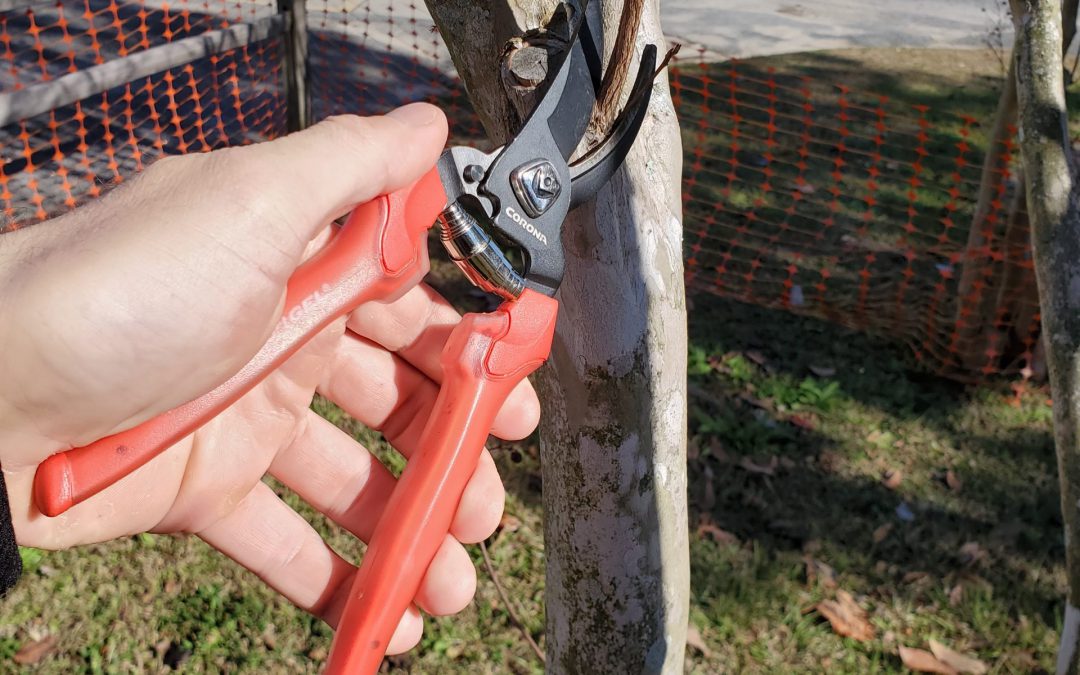
by Ashley Stonecipher | Jan 26, 2022

Violas. Photo Credit: University of Florida/IFAS Extension
It is freezing cold this week and hard to believe that we are already talking about “What to Plant” and “What to Do” to get started early. In North Florida there are cool-season annuals that can be planted now. The list includes pansies, violas, petunias, and snapdragons. As we are coming to the end of January it is time to plant crinum, agapanthus and gloriosa lily bulbs. Make sure to mulch these areas after planting to protect them from the cold temperatures. This is also the month to plant camellias, which these come in many colors and forms that your local nurseries will carry this time of year. If you haven’t planted all your cool season crops there is still time to do that now such as broccoli, kale, carrots, and lettuce. Irish potatoes can be planted now as well.
Now you might be asking “What can I do?”. January is a great time to prune non-spring flowering shrubs and trees to improve their form. This is a good time to plant deciduous fruit trees, this will give their roots time to develop before the warmer spring temperatures. Since existing trees are dormant, it is a good time to prune and fertilize them. When the temperatures are near freezing many of the tender plants will need to be covered to minimize damage. It’s a good time to plant a tree. Hurricane-resistant trees include live oaks, bald cypress, cabbage palms, and southern magnolias. It’s time to remove those dead spent seed pods on your crape myrtles and removing any crossing branches and twiggy growth will improve the appearance and the form of the plant.
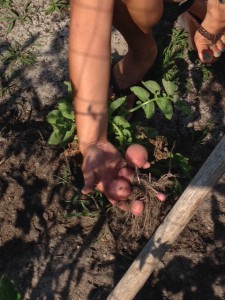
Potatoes planted in mid-February were ready to harvest in mid-May in Bay County. Photo: Vicki Evans, UF/IFAS Master Gardener of the plant.
As we go into February it will soon be time to apply a preemergence weed killer to your lawns to prevent warm-season weeds. Temperatures must rise to 65°F for 4 to 5 consecutive days before you do a preemergence application and make sure you are not using a weed and feed fertilizer. Citrus and other fruit trees can be fertilized at this time. The amount and frequency will depend on the age and type of fruit tree you are growing. Avoid pruning Citrus until spring to avoid any injury since cold temperatures are still possible. It is time to prune those roses this month to remove damaged canes and improve the overall form. After the pruning is complete you can fertilize and apply a fresh layer of mulch. They should begin blooming within 8 to 9 weeks after being pruned.
Dianthus, pansies, violas, and dusty millers are annuals that can take a chill and should be planted in February. You can continue to plant crinum and agapanthus this month and add on amaryllis and rain lily bulbs as well. If it has been dry make sure to provide plenty of water for the bulbs to establish and continue to protect them from the cold by adding mulch. Trees and shrubs will begin to bloom this month including red maples and star magnolias. Continue planting potatoes throughout the month and towards the end of February warm-season crops like tomatoes and pepper can be planted but be prepared to protect them from any late frosts.
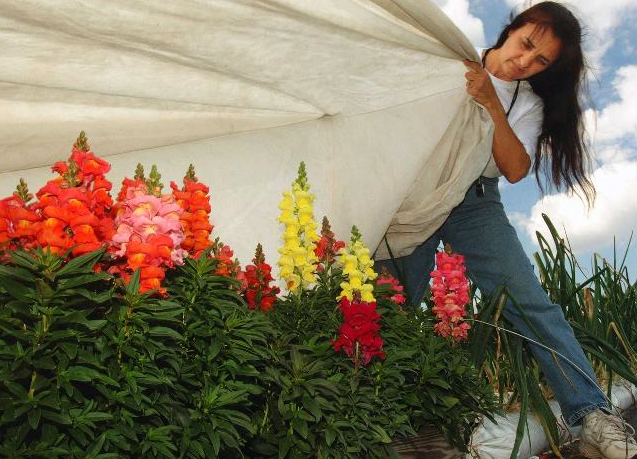
by Ray Bodrey | Jan 13, 2022
January and February are typically the coldest months in Florida. Low temperatures can damage even the more cold-hardy plants. However, there are measures that can be done to help cold-damaged plants recover.
After a frost or freeze, see if your plants are dry. Even injured plants need water. Plants can be greatly damaged if the temperature drops suddenly, as they have no time to acclimate to the freezing temperatures. These freezing temps cause ice crystals to form in plants cells. These crystals expand, rupturing the cell walls and preventing the plant from maintaining shape. If severe, this can certainly kill tender plants. On more cold hardy plants, damaged foliage will appear wilted and curled down. In a few hours or days, it will darken and turn black. Flowers, buds, and new growth often dieback under freezing temps.
After freezing temperatures occur, it’s important to remove damaged leaves and flowers as soon as they turn brown or black. This will help prevent diseases from occurring. Pruning should be postponed until cold temperatures are no longer expected and new growth begins to appear on the plant. This practice ensures live wood, which appears dead from losing its leaves, is not mistakenly removed from the plant. Cold damaged wood can be detected by examining the cambium layer (under the bark) of the plant. If it has black or brown discoloration, it is damaged and should be pruned back behind these points. Plants should be fertilized in the spring, to encourage new growth.
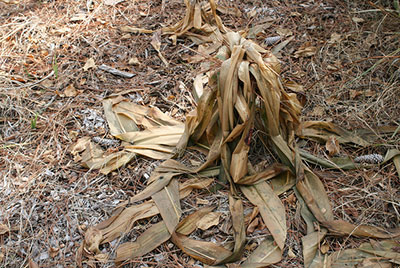
Cold damage. Photo Credit: University of Florida/IFAS
What about proactive care? You can accomplish this by moving potted plants indoors and covering tender landscape plants with a protective covering. Protective covering can include old bed sheet, pieces of material or fabric, and cardboard boxes. Be careful not to let the protective covering touch the plants. The surface of the covering will become as cold as the air temperatures and may damage any tender leaves it encounters. Also, don’t forget to remove the covering the next day when temperature raises this is important so the plants do not “bake” in the warmer temperatures. Plants placed near the house, lights, or other structures, which shelter them from wind, will be more protected than those fully exposed to the cold air.
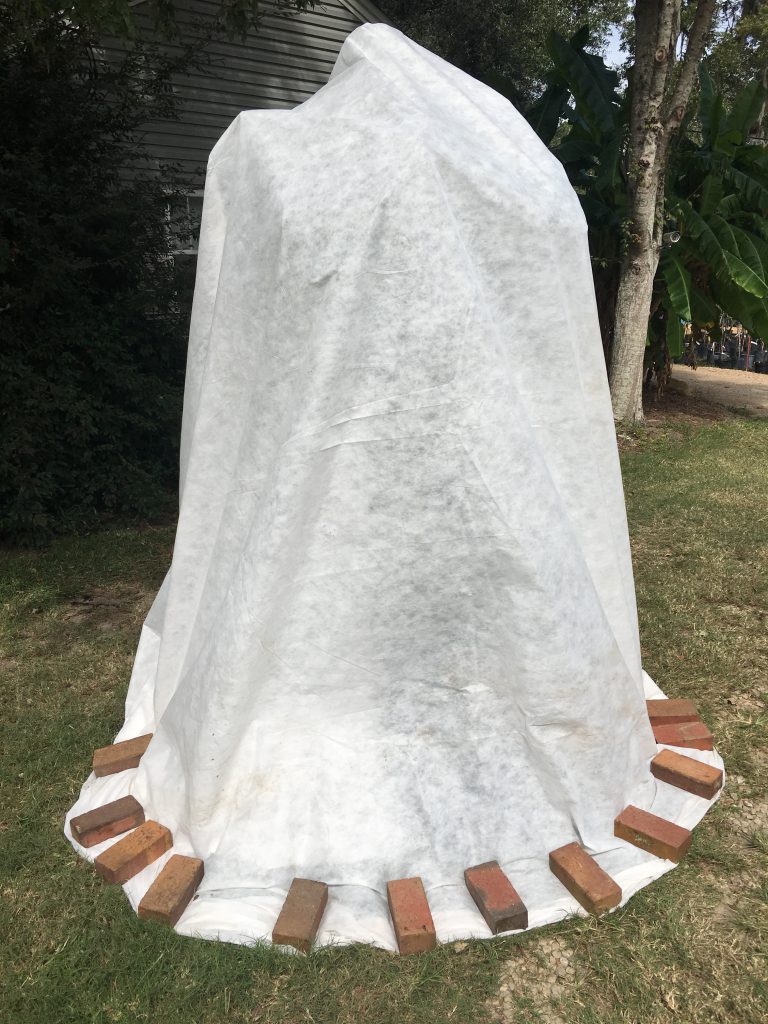
Use frost cloth to completely cover cold sensitive plants. Be sure to make complete contact with the ground and use heavy objects to keep the fabric secure. Photo by Jonathan Burns.
For more information on freeze damage plants contact your local county extension office.
Supporting information for this article can be found in the UF/IFAS Extension EDIS publication: “Cold Protection of Landscape Plants”, by Sydney Park Brown: https://edis.ifas.ufl.edu/publication/mg025
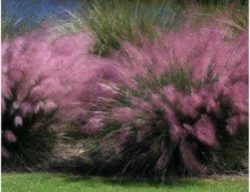
by Sheila Dunning | Feb 18, 2021
The term “ornamental grass” is a catch-all phrase used to describe grasses and “grass-like” plants. Individual species are adapted to a wide variety of landscape sites (i.e., wet or dry, sun or shade, hot or cold climates, and varied salt tolerance). Growth habits range from low ground covers to intermediate shrub-like plants to very tall hedge-like plants. Ornamental grasses are very dynamic; the size, shape, texture, and color of grass changes with every season.
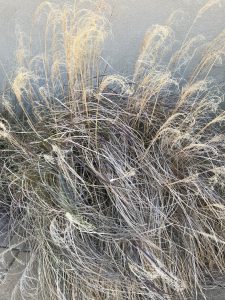
Deciduous Ornamental Grass
Grasses with foliage that dies in the winter and remains dormant until the weather warms in the spring are considered deciduous. The winter character of deciduous ornamental grasses adds tremendous interest to the winter garden when contrasted with evergreen plants or structures such as walls or fences. The dried foliage of deciduous grasses creates sound as it expands and contracts in response to changes in temperature or moisture, while interaction with wind creates movement in the garden. For these reasons, pruning of the dead foliage and inflorescences is not recommended at the time of the first frost.
Pruning of ornamental grasses should be done in late winter or early spring, just prior to new shoot growth. In Northwest Florida, gardeners should target the end of February to prune ornamental grasses. For deciduous grasses, such as Japanese silver grass (Miscanthus sinensis), the old foliage may be completely removed within inches of the soil. Be cautious to not remove the growth point by leaving the grass clump at least 4 inches high. For evergreen grasses, such as muhly grass (Muhlenbergia capillaris), the ragged leaves can be removed to neaten the appearance of the plant without shortening all the way to the ground. So, depending on the damaged portions, the remaining grass clump can be 6-18 inches high after pruning. Grasses recover quickly from a heavier pruning. Within a few months the plant will have completely regrown. If desired, old flower stalks and seed heads may be removed any time they no longer have a neat appearance. For more information on ornamental grass species and growing tips, please visit the EDIS Publication: Considerations for Selection and Use of Ornamental Grasses.
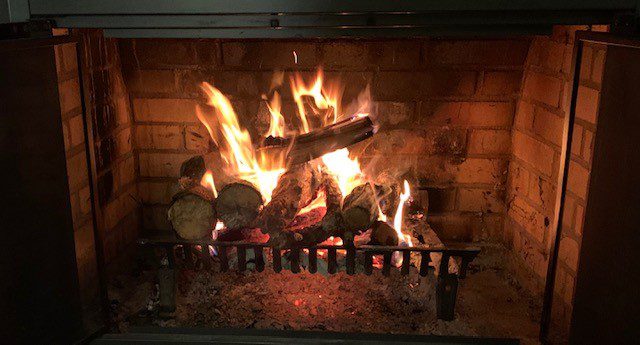
by Larry Williams | Feb 11, 2021
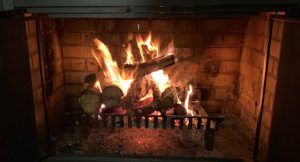
Be careful when bringing firewood indoors. Photo credit: Larry Williams
Your firewood pile could be “bugged.” Many insects like to overwinter in wood. A wood pile is an ideal place for some insects to survive the winter. They don’t know that you intend to bring their winter home indoors during cold weather.
During colder weather, you can unknowingly bring in pests such as spiders, beetles and roaches when you bring in firewood. It’s best to bring in firewood only when you are ready to use it. Otherwise, those pests could become active and start crawling around inside your house. Many insects are potential problems indoors and there are usually control options once insects move into your home. However, preventing the insects from getting inside is the best approach.
If you store wood indoors for short periods of time, it is a good idea to clean the storage area after you have used the wood. Using a first-in, first-out guideline as much as possible will reduce chances of insect problems.
It’s best to keep your wood pile off the ground and away from the house. This will make it less inviting to insects and help the wood dry. It’s not difficult to keep the wood off the ground. The wood can be stacked on a base of wooden pallets, bricks or blocks, which will allow air movement under the wood. The wood can also be covered with a waterproof tarp or stored in a shed. Regardless of how it is stored, avoid spraying firewood with insecticides. When burned, insecticide treated wood may give off harmful fumes.
Some critters that live in firewood can be harmful to humans. To avoid a painful sting or bite from insects, spiders or scorpions (no Florida scorpion is considered poisonous, but they can inflict a painful sting), it is a good practice to wear gloves when picking up logs from a wood pile.
Firewood can be a good source of heat during our cold weather. If you’re careful with how you handle your firewood, hopefully it will warm you, not “bug” you.
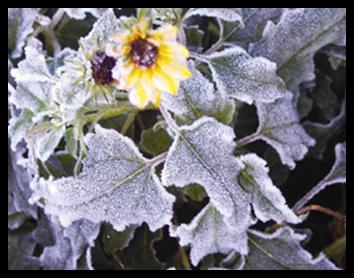
by Sheila Dunning | Dec 4, 2020
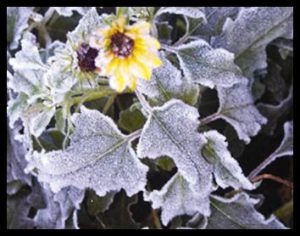
Frost on Dune Sunflower
Picture by: Pam Brown
UF/IFAS Extension
December is finally here and that means consistent nights of watching for dropping temperatures. Tropical plants and newly installed shrubs are susceptible to cold injury. Those colorful, blooming plants that have added a tropical look to the landscape all summer may begin to suffer when the temperatures drop below 500 F. Leaves may turn yellow and flowering stops. These plants will need to be moved inside or have temporary greenhouse built around them. But, hardy plants that haven’t established a sufficient root system will also need additional attention when the temperatures drop dramatically.
The ability of plants to endure a freeze depends on the species and the weather leading up to the extra cold night. Gradual decreases in temperatures helps plants acclimate to winter. But, a sudden one day drop of 40-50 degrees results in a rapid freeze that causes ice to form inside the plant cells. Leaf and stem tissue expands so quickly that it splits, resulting in parts of the plant incapable of transporting water and nutrients, as well as, performing photosynthesis. However, it may be late the following spring before the damage is noticed, when that section of the plant has slowly staved to death.
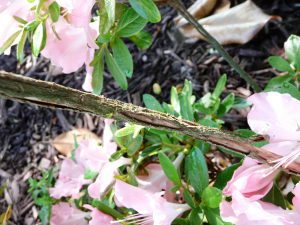
Cracked bark from frost
Additionally, plants can experience desiccation or drying out. This happens when dry winds and solar radiation result in the loss of more water from the leaves than can be transported by a cold root system. The resulting symptom is marginal and/or tip burning of leaves that leads to totally brown leaves.
Freezes (when the temperature drops to 320 F) are characterized as radiational or advective. Radiational freezes occur on calm, clear nights when heat radiates from the surfaces of plants, making them colder than the air due to the rapid loss of heat. If there is moisture in the air, ice will also form on the surfaces. Under these conditions, ice forms between plant cells, rather than within the individual cells. Most hardy plants can tolerate these type of freezes if they are properly hydrated.
Advective freezes occur when cold northern winds move in rapidly, dropping temperatures quickly, and causing widespread foliage desiccation. Cultivation and maintenance practices can impact a plant’s ability to endure extended periods of low temperatures. Shade-tolerant species installed under the canopy of a tree typically display less injury from radiational freezes because the trapped heat from the ground and the overhead foliage creates a microclimate. Well-watered soil around a plant will absorb solar radiation during the day and re-radiate heat over night, raising the temperature around the plants. Shrubs that are not pruned in the late summer or fall have leaves that can withstand frost and wind. But, the removal of foliage late in the growing season triggers a flush of new growth, that is very sensitive to lower temperatures. The same response can result from fertilizer applications after plant’s have slowed down in growth.
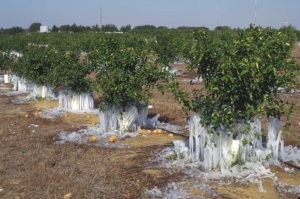
Irrigation Frost Protection on Citrus
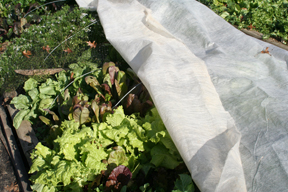
Row Cover
Picture by: Univ of Maryland Extension
So, what can you do to prepare for upcoming freezing temperatures? Begin by avoiding pruning and fertilizing at the end of the season and making sure that the plants have been watered within 24 hours of a cold night. Next, insulate against water loss and increase heat radiation by adding a three-inch of mulch, as well as, covering the trunks of sensitive trees with a commercial tree wrap. Then, consider what needs to be covered. Frost cloth or other breathable fabrics can trap heat for the night and provide a protective layer from frost settling on the leaves. It needs to be placed by mid-afternoon and removed the next day when temperatures are above 320 F. Plastic is not recommended unless the timing regime can be followed reliably and a structure is used under the material to keep the plastic off the foliage. Anchoring of the cover is critically important in the event of an advective freeze.
Finally, turn off the sprinkler system. Commercial agriculture often uses a running irrigation system to keep the leaf surface temperatures near, but not below, 320 F because sprinkling utilizes latent heat released when water changes from a liquid to a solid state. The thin layer of ice melts and re-freezes on the surface throughout the night, without ice forming within the plant tissues. For the technique to work, sprinkling must begin as freezing temperatures are reached and continue until thawing is complete. Landscape systems are not designed to deliver the amount of water over the length of time required to accomplish this type of frost protection.
When the cold nights have passed, don’t forget to check your plants for water. But, wait until winter has passed before pruning out the frost damaged stems.















